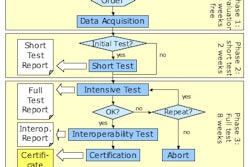If PACS implementation seems to be slowing down these days, that's because it is, according to industry experts. While the reasons for the slowdown are difficult to grasp, the situation is likely to generally worsen before it gets better.
A combination of factors -- more and more hospitals moving to implement PACS, a possible shortage of staff on the vendor side, data migration and operational issues tied to second-generation PACS implementation, and other issues -- is working against quick system implementation, according to sources contacted by AuntMinnie.com.
When breaking down the PACS implementation process into discrete stages, the average time to go live, including the amount of time spent on vendor selection, is easily 13 months or more in many hospital-based organizations, said Scott Grier, a Sarasota, FL-based independent healthcare consultant who specializes in PACS issues.
For example, a prospective PACS purchaser might spend a few days at the RSNA meeting looking at products and meeting with vendors, then take, on average, six months to select a vendor, Grier said. Adding one month's time to complete vendor contract negotiations, three months to receive hardware, and four months for the vendor's tech people to show up, the go-live date becomes January 1, 13 months after the RSNA visits -- that is, if it's an extremely smooth implementation.
That timeline doesn't even include a full two months to migrate your data if your organization is doing a PACS replacement, or, conversely, a few months preparing a first-time user's network and platform infrastructure for the new system, Grier said.
A slow timetable
One major factor for the slow timetable is the increasing number of medium-sized and even small hospital organizations that are now implementing PACS for the first time. About 50% of hospitals in the U.S. now have at least some PACS components, while around 70% of hospitals with 300 or more beds have some version of PACS, according to Mike Davis, executive vice president of data analysis organization HIMSS Analytics of Chicago. That figure represents a big leap in PACS implementations among smaller hospitals with fewer than 300 beds, Davis said.
In addition, some consultants say that PACS vendors are chronically understaffed on both the manufacturing and implementation sides of their organizations, making the waits longer for PACS to go live and creating dissatisfaction among customers.
"Across the board, all the major vendors seem to be running out of steam in getting these things done," said Vincent Norlock, a managing consultant who specializes in PACS work with First Consulting Group of Long Beach, CA. "They don't have the people, and they don't have the delivery mechanisms, to keep a bunch of enterprise-sized customers moving forward fast enough."
The smaller vendors seem to be doing a bit better, but several major vendors' sales "have gone through the floor because their sales can't keep up with these commitments," he said.
Customer frustration
There is widespread dissatisfaction among clinicians and hospital managers with the pace of PACS implementations, said Michael Cannavo, president of Image Management Consultants in Winter Springs, FL.
Equally importantly, however, the whole process of decision-making on the customer side is slowing because "the stakes are higher than they used to be, and because people don't know how the Deficit Reduction Act (DRA) of 2005 will impact them," he said.
Executives from a wide range of vendors contacted for this story insist, however, they are fully staffed, and that, fundamentally, most delays are coming from the customer side, either in the vendor selection process or in the network infrastructure and data migration areas.
Despite such assertions, many customers are experiencing delays; even those patient-care organizations whose decision-making process has been speedy and whose executives want to buy are frequently finding themselves stymied.
For example, at the 30-bed Morton General Hospital in southwest Washington state, radiology department director Tricia Meier was discouraged to find out that there would be numerous process delays, some of them vendor-related, before her hospital was able to go live in November of last year, eight months after she and her colleagues had signed a contract with their vendor.
Her radiology department's situation was a complicated and challenging one, relying on a corps of four radiologists based 45 minutes away at Providence Centralia Hospital in Centralia, WA. These radiologists drove 45 minutes each way, twice a week, to read films at Morton General.
Meier and her colleagues purchased the same PACS Providence Centralia had, in order to optimize workflow; even so, there were several delays, resulting in a 13-month process from the start of vendor selection to the go-live date, that Meier said was frustrating and surprising for all involved.
Stuart Gardner, president and CEO of SG&A Consulting in Arlington, TX, said that in many cases, part of the fault does lie with the customer organization.
"Everyone's focused on 'How fast can we get up and running?'" he said. What's resulted in all these fast deployments is that key network infrastructure steps have been fumbled, and clinicians and managers haven't been adequately trained, he explained.
No one interviewed for this article sees things changing anytime soon. Rather, said some, the whole way people think about PACS networks has to change.
In the end, said Michael Gray, principal of Gray Consulting, Novato, CA, "The notion of buying these monolithic, application-specific beasts every five years and moving all the data from one to the other is already ridiculous, and is becoming more so. What we need to do is to build an enterprise archive that is actually capable of surviving two or three generations of PACS."
By Mark Hagland
AuntMinnie.com staff writer
February 20, 2007
Related Reading
Part II: Proactive PACS data migration -- A better way to address the inevitable, January 4, 2007
Cardiology image and information system integration, December 26, 2006
Part I: Proactive PACS data migration -- A better way to address the inevitable, October 26, 2006
Part XIII: Exploring PACS Secrets -- Penny-wise, pound-foolish, October 16, 2006
Part XII: Exploring PACS Secrets -- PACS and marriage, August 15, 2006
Copyright © 2007 AuntMinnie.com



















